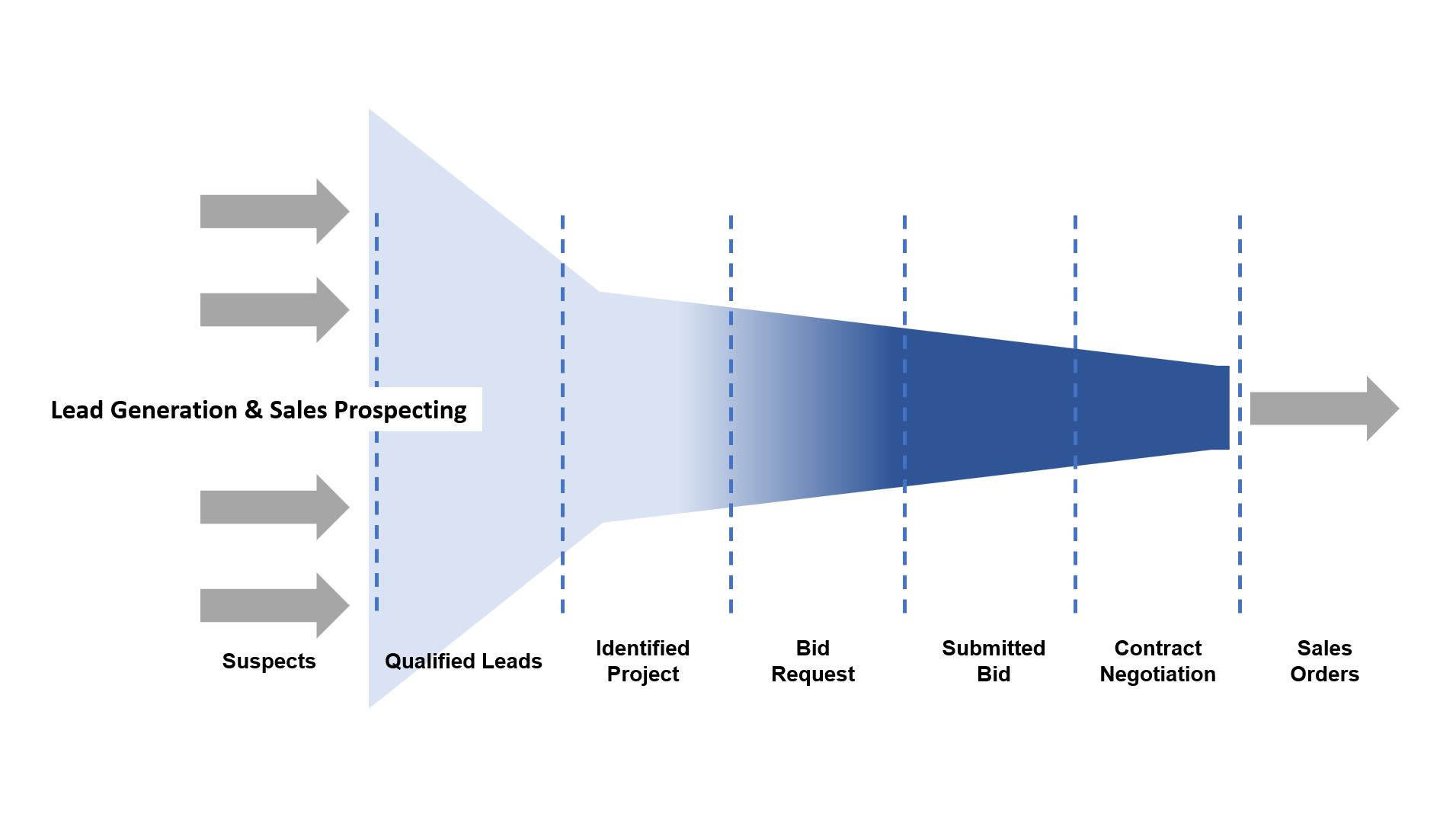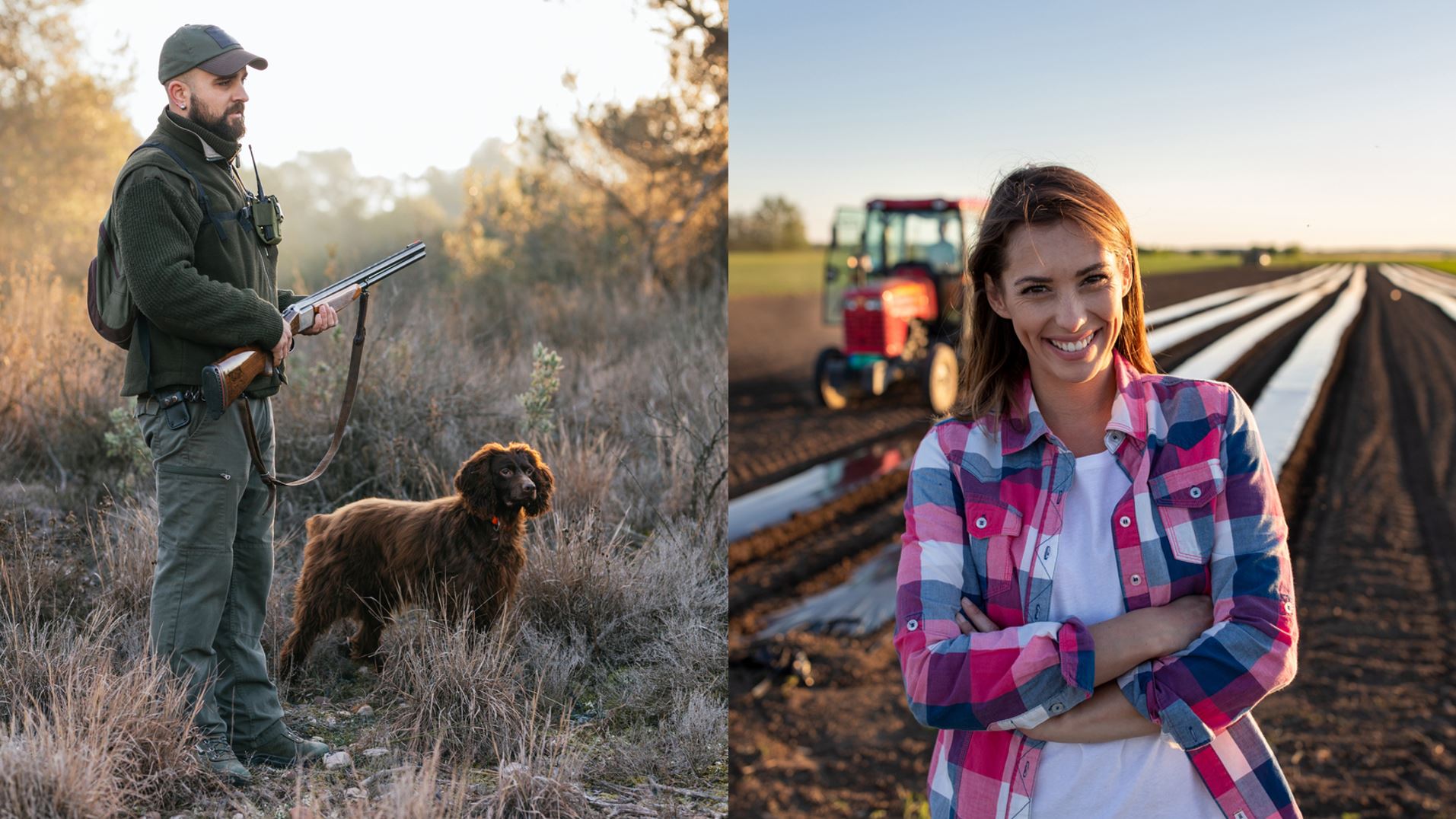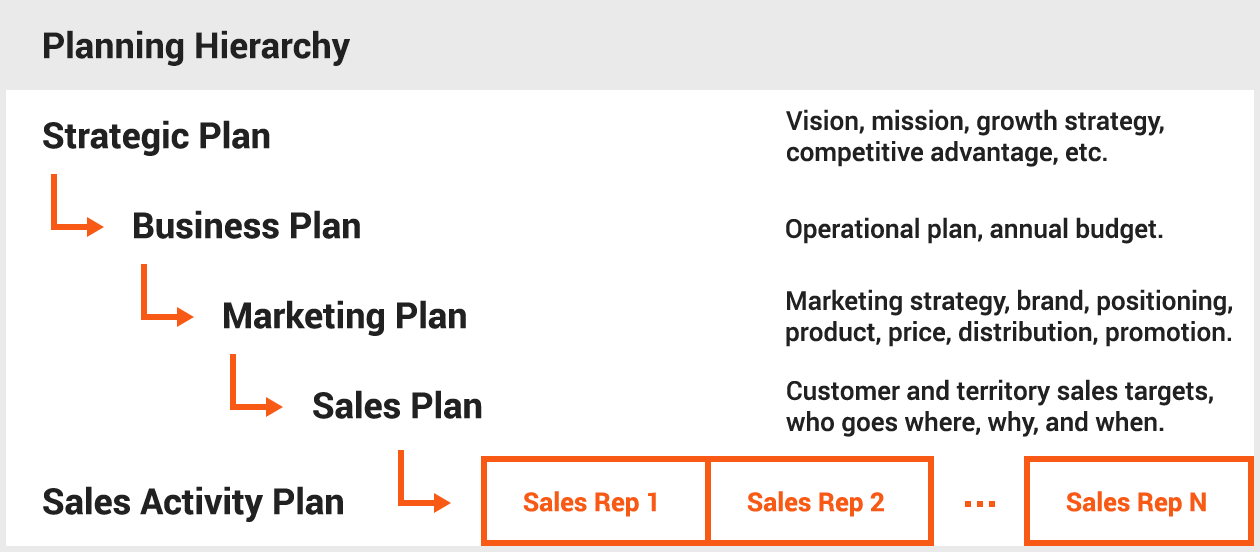06 October 2022
Sales Management is a business discipline aimed at orchestrating and optimizing the activities of a sales force. Many organizations blunt the effectiveness of sales management through not understanding the purpose of the role, and expecting sales managers to also sell (the player/coach concept).
We also examine in this article the question "do great sales people also make great sales managers?" Effective sales management can be a powerful driver of competitive advantage and growth. But the important thing is to understand what a sales manager does...
Having the right people, in the right places, doing the right things

In theory, sales people could be self-directed, however even the best ones benefit from an objective review of their priorities, activities, and techniques and need to be guided to ensure their efforts are aligned with the business strategy.
Practical experience reveals that direction and supervision of a sales team's activities improves results. Another way of looking at sales management is that it translates the marketing plan (or at least, the promotion strategy) into front line selling action.
However, sales management is more than just developing and executing a sales plan.
Sales Management is the supervision of all sales activities to optimize performance.
Since sales is mostly about people management (and people are expensive resources) optimization (sales productivity) is a key metric that needs to be managed.
Getting the best results from people is a big topic embracing leadership, culture, coaching, direction and supervision, and results measurement. However, an effective sales manager is also responsible for team right-sizing, structure, and sales department administrative functions.
In simple terms, the sales manager is responsible for sales outcomes (orders).
The Sales Pipeline as a sales management tool

One of the main challenges of sales management is wrangling a team of sales people chasing a portfolio of sales opportunities that are each at various stages from first enquiry to nearly signing on the dotted line. From this sea of activity where often there is insufficient visibility to the sales manager of what is happening at the selling coal face, must emerge some semblance of order.
The sales pipeline is the best tool for this job.
In B2B selling, the sales manager has one eye on the sales pipeline and the other eye on the sales team. And, in the back of the sales manager's mind is the sales plan.
Of course, the best method of running a sales pipeline is to use CRM software that has this function built-in.
Sales Pipeline Management is the process of regularly analyzing the pipeline to forecast future sales to inform resource planning and directing sales activities to ensure that the required number of sales orders are progressing through the pipeline to meet sales targets.
The importance of the sales pipeline becomes greater in businesses where sales lead times are longer (low volume high value sales).
Managing the sales team is the primary method for moving opportunities through the sales pipeline to eventually generate sales.
However, in organizations where a large amount of repeat business comes from existing customers, account management has greater importance.
The style of sales management (and the allocation of priorities) is dependent on the selling model and the sales organization structure.
The selling model describes the demand generation method - the degree to which sales enquiry is based on an inbound marketing model versus outbound. This impacts sales management.
The primary role of the sales manager

The sales manager is responsible for managing the sales process on behalf of the organization. Sales is not derived so much from good talent (the 'natural' salesperson); the important factor is process. Having good processes produces sales. And the reason for this is quite simple....
More sales are lost through neglect than through poor sales technique.
The sales department is a machine and sales management is about running the machine at maximum speed efficiently.
The most important sales management activity is to direct, supervise, and motivate the sales force.
Maximizing productivity is achieved through directing the focus of the sales team toward the highest value and most prospective opportunities.
And while this might sound like stating the bleeding obvious, this management oversight is frequently absent because sales teams are often self-managing and the sales manager is fully occupied chasing higher value sales opportunities and attending to the needs of the rest of the organisation.
Sales productivity has three parts:
- The quantity of selling efforts: the sales manager must assist the sales person to determine what constitutes a worthwhile sales activity and ensure that these activities happen as often as possible. For example face-to-face selling time. In B2B sales time spent face-to-face with prospects and customers delivers results. Measuring the number of customer interactions (face-to-face or other) being achieved is important. Due to traffic conditions, it is difficult to achieve more than 3 sales appointments per day in Sydney and Melbourne. Taking into account annual leave and public holidays there are around 230 working days in a year. 3 visits per day would yield 690 face-to-face visits per year. However, sales rep's have other duties; quotes, telephone calls and emails, problem solving, training, sales meetings etc. Further, very few people can operate at 100% efficiency all the time; so goof-off time further depletes the available hours.
The average sales rep would be lucky to achieve 200 sales visits in a year. At (say) $130,000 annual cost that works out to roughly $650 per visit. It's therefore important that every visit is planned; the purpose is identified, the visit is prepared for, and the outcomes documented.
-
The quality of selling efforts: Sales visits vary considerably in quality. There are what are called "coffee visits" where not much more than having a chat is achieved. And while maintaining contact with customers and potential customers is important, the sales manager should monitor both the purpose of sales calls and the outcomes achieved. This applies to all sales activities. It is easy for sales representatives to fritter time away on activities that have little impact on sales outcomes. Later, we discuss the sales pipeline concept. Sales team activities should be aligned with progressing opportunities along the sales pipeline. Efficiency comes from focus and the sales pipeline is a tool for improving focus.
-
Sales orders achieved: If both the quantity of selling and the quality of sales activities are maximized, it follows that more sales should be achieved. So, the ultimate measure of sales productivity is sales. If sales are not meeting expectations (budget) then the sales manager looks to quantity and quality of selling efforts.
While not the only responsibility of the sales manager, maximizing sales productivity is the primary role. Other responsibilities either support achieving sales productivity or are subordinate.
Sales Manager - other roles and responsibilities

Apart from directing and supervising the activities of the sales force, the sales manager is responsible for...
-
Sales team development: This is achieved through training, coaching/mentoring, and recruitment.
-
Sales department culture: Culture is the environment within which the sales team works and the prevailing team attitude toward the achievement of worthwhile outcomes. Culture affects individual job satisfaction and the capacity to attract and retain top talent. In selling, confidence and energy are psychological factors that impact results. Celebrating success is a time honored sales team building method. And while the finance department particularly may view the expense of the "big lunch" after a sales win as a waste ("after all, that's we pay them to do isn't it?") the psychology is simple. The high of the big win becomes addictive.
-
Sales department operations, processes, and systems: The efficient operation of the sales department is the sales manager's responsibility and this requires often reviewing how information is processed and what IT systems are used to support this. The sales manager should be regularly asking "is there a more efficient way to do this?" This occasionally leads to reorganizing the department structure and reviewing the selling model.
-
Quote, or bid management and approval: The sales manager is responsible for the quality, accuracy, and conformity to business terms and conditions of all proposals put forward to customers. The sales manager will have delegated authority to approve proposals up to a certain value and/or project type. The sales manager will seek approval from others for bids above delegated authority.
-
Planning: The regular preparation and fine tuning the sales plan is undertaken by the sales manager. This is usually an annual activity, however often a 6 monthly update is undertaken to take account of fast moving market conditions.
-
Reporting: Naturally the activities of the sales department and the sales department's view of the market are of crucial interest to the rest of the management team and a monthly report is prepared. An important heading in the sales report is the sales order forecast which informs other department heads for their resource planning. The sales pipeline (again) is the critical tool for sales order forecasting.
-
Workplace harmony: Any manager with direct reports has a primary responsibility for the physical and emotional safety of the people they supervise. Making sure everybody is playing nicely and not breaching corporate policy is part of the sales manager's remit.
-
Administration: Monitoring sales operational expenses (particularly sales team expenses) and the suitability of the working environment.
The above duties and responsibilities are listed in nice neat categories but like all management the reality is not so simple. Each area of responsibility interacts to form complex outcomes. For example, poor processes will frustrate the sales team and this will impair sales department culture leading to lower productivity.
The sales manager as a field commander

The sales manager directs the movements and operational tactics of the sales force to ensure maximum return for their time invested.
The sales manager directs who goes where, why, and when
As stated previously, sales people are an expensive resource and their time shouldn't be wasted on activities that will not contribute to selling outcomes.
The primary tool for discussing, planning, and directing activities in the field is the sales pipeline. The sales pipeline should form the centre piece of sales meetings (either as a group or individually) where every sales opportunity is discussed, its current status updated, and the actions required to progress each opportunity through the pipeline toward a sale.
The sales manager assigns each sales person a set of tasks to be completed before the next sales meeting aimed at progressing opportunities.
The sales pipeline can be thought of as the field commander's strategic map displaying the battlefield where progress on multiple fronts is monitored and the pieces are moved around to greatest affect. The sales force is a finite resource and must be deployed where it can have the greatest impact in response to a constantly changing market place.
The sales manager as a coach

To encourage the best performance from the team requires providing mentoring and coaching.
Just as in sport, the best coaching isn't telling people off for under performance but requires encouragement, player psychology, skills training, game planning, and on field direction. The sales manager needs to adopt similar skills and techniques as a sports coach.
Of crucial importance is making sure the game plan is clear, and the role of each player is clearly understood.
The sales manager is rarely hands-off. The sales manager keeps a close watch on the sales teams' on field performance and provides direction before, during, and after the game. "When are you visiting ACME manufacturing?", "How did that sales call go?", "I'd like to walk through the proposal with you."
Sales management requires constant monitoring and fine-tuning of all front line selling activities. Constant focus and discussion of each individual sales representative's activities drives sales team momentum and keeps the sales force focused on the prize.
Sales manager as a strategist

Sales is often a game of strategy (particular in big-ticket B2B strategic selling), and the sales manager plays a critical role in strategy development and the direction of the sales team toward closing an opportunity.
Strategy is about making choices. The sales manager analyses the available options for winning deals and chooses the best.
In sales management, the need to develop a strategy exists at several levels...
Sales strategy: The sales manager prepares a forward plan (usually annually) and makes decisions about how much selling time will be devoted toward supporting the organization's growth plan, looking after existing customers (account management also known as 'farming'), and the division of selling time between chasing different market segments, promoting product lines etc.
Capture planning: In B2B selling one of the most important decisions is about deciding to bid or not to bid. Capture Planning is the tool used by most organizations to help inform this decision. Large opportunities soak-up enormous resources to produce a bid. Better to know early that the opportunity is a dud than waste sales resources that could be better used to chase more viable opportunities. The sales manager has primary responsibility for BID/NO-BID decision making. Capture planning informs both the bid strategy, and for combating the competition...
Bid strategy: Every proposal or bid submitted includes decisions about price, product specification, business terms and other variables. These decisions are a compromise between probability of winning versus the potential profitability of the sales. These decisions are made with respect to current order book ("are we desperate for work?"), likely competition ("who else is bidding?"), and the potential value of the long term customer relationship (particularly if this is a first time bid to a new potential customer).
Combating competition: In sales, the competition is ever present. Sometimes a single competitor emerges that seems determined to win every deal (kamikaze competitor). The sales manager must analyze such factors and develop an appropriate strategic response.
Sales Management - tactician and skills coach

Everything else written so-far (in this article) is about managing people and process. We haven't spoken about 'selling' as-such.
When most people hear the word "selling" we think of a glib, persuasive person using Sales Techniques 101 and generally being annoying.
In almost all selling situations high-pressure sales techniques are counter-productive; more likely to make the customer walk away than buy.
However, selling involves understanding, explaining, some persuasion, and certainly the need to build rapport with the customer. In B2B selling (especially solution selling and large deals) multiple people on both sides (selling team and buying team) are involved and sales people need the ability to read situations, identify individual attitudes, allegiances and politics. The ability to present and negotiate are important as well.
There are many techniques and tactics that are needed to progress opportunities through the various pipeline stages and to finally kick the sale over the line.
As part of optimizing the performance of the sales team, the sales manager is responsible for the individual development of sales team members to improve their selling skills. This is both achieved through constantly coaching and mentoring sales team members and arranging for formal sales training.
Managing the sales team structure

Read more about sales organization structure.
Sales team structures vary considerably based on industry, product, transaction size, selling model and individual creativity. The sales manager is responsible for developing the best possible structure to suit the business.
The selling model is a key driver of sales team structure. The selling model defines how you structure your sales efforts to achieve maximum efficiency and effectiveness and aligns with how your customer wants to purchase, your distribution model, and your demand creation method.
Sales teams can be structured as lone wolves (every rep chasing opportunities with no assigned sales territories), allocated to territories (geographic, industry, other segmentation), working in teams, or split by function.
In B2B Selling (particularly very large sales value and long lead times) sales people specialize in various stages of the pipeline. For example, a business development manager would identify opportunities and do the initial qualification and relationship building, a project engineer would then takeover to help the customer develop a business case, a bid team would then takeover to prepare the bid, and a project closing specialist would then kick the deal over the line.
There are many ways to structure a sales team. Sales Management includes assessing the existing sales team structure and thinking "is there a better way to do this?" However, mostly the sales manager is encouraging the best performance from the existing structure through managing people and processes.
Managing sales team performance

In the traditional or flat sales organization structure (where sales representatives essentially have equal status and are allocated a sales territory), the performance of each sales representative generally conforms to the above chart.
New comers: the poorest performers are usually the sales representatives who have recently joined the team. They are still "finding their feet", learning the product range, establishing a sales pipeline, The role of the sales manager is to help them get up to speed as soon as possible.
Question marks: after being in the role for (say) nearing 12 months it is expected that new sales team members should be generating higher sales. However, not all will reach average sales levels. They may not be suited to sales work, or have other issues impeding their performance. The sales manager has a decision to make; persevere or manage them out of the business?
Middle majority: most of the experienced sales team members will consistently achieve a similar average level of sales. If the middle majority of sales are not fairly even then further analysis iwill provide clues for the sales manager to implement corrective action...
- The sales territories may need to be re-calibrated. Some territories are more fertile than others. If the representative servicing that patch is flat-out quoting and not doing much field work then this might be a clue that some of the territory needs to be handed over to a less performing rep or new one recruited.
- Individuals need more attention (a sales productivity issue)
- An entrenched competitor has greater market share in a territory (typically a local company, product, or industry specialist). Some strategy work is needed.
Balancing the performance of the sales team (each team member producing similar and maximum results) is the key to maximizing overall sales performance.
Rock Star: In every sales team there is usually one person who consistently outperforms the rest of the team by a considerable margin. The rest of the sales team will believe that person has been allocated an easy sales territory or is receiving favorable treatment. The truth is usually they are highly organized, have a highly developed instinct for quality sales opportunities, ruthlessly avoid time wasting activities, and work hard. These success factors are more important than great sales technique (e.g. being a great closer). For the sales manager they are often a problem to manage because they know they are highly valued and often bend the rules, avoid sales meetings, don't waste time on reports, and hate being managed.
Contender: There is often a second person in the team trying hard to emulate the performance of the rock star. Good for them.
The existence of the rock star is a perplexing problem for sales management. There is always the nagging question "why isn't everyone in the team performing at that level?" The rock star demonstrates that high performance is possible. However, the reality is the majority of the sales team are either just not capable of performing at that level or are not prepared to make the personal sacrifices needed. Rock stars are unicorns and while it's nice to have one, they are a distraction.
The challenge for the sales manager is to identify ways to lift the performance of the middle majority (where most of the sales horsepower exists) without wasting time looking for more unicorns.
Building a highly performing team is about enabling ordinary people to achieve extraordinary things.
Focusing on improving sales process by stripping-out or automating low-value but necessary tasks is often a good place to start, however sales management has many moving parts all of which contribute to performance improvement. Rather than looking for that one big fix that will deliver a step change improvement, more likely tweaking 10 things that each add a percent or two will deliver the boost.
How different selling models impact the type of sales management needed

The greatest difference between the style of sales management required is related to the extent to which the selling model is hunter versus farmer.
The hunter selling model is most strongly related to firms specializing in project delivery. Many project delivery firms (think large infrastructure projects like bridges, dams, roads, and tunnels) the customer may only ever buy once. Repeat business is a low probability. Consequently project firms are continuously looking for their next project. There is a heavy emphasis on hunting and moving projects through the sales pipeline.
Firms that rely heavily on farming a customer base for repeat business have a heavy reliance on account management. Such organizations are also on the look out for new accounts (hunting) but the predominant activity is farming; less time is spent discussing the sales pipeline (although, new business opportunities often arise from organizations that are considered "customers". Customers often routinely deal with multiple suppliers and ask for quotes from more than one supplier).
Many firms have a hybrid selling model. They undertake both project work and (for example) have a service and spare parts business as well. In some selling models the project is a loss leader to the recurrent revenue generated through servicing and supplying spare parts after the equipment or software is installed.
Sales planning

Another important responsibility for the sales manager is the development of annual sales plan.
Sales Budget:
The obvious item (because it is the most important) in a sales plan is the sales budget. Other members of the management team will want to know what the revenue and gross profit budget is for the up-coming planning period (usually 12 months).
The revenue budget should be evidenced based and not simply last year's actual revenue "plus a bit."
In organisations that are customer-base-centric (sales are mostly derived from key accounts) the process is to step through every account, look at the sales history and ask the question "will we be getting more, less, or the same from this customer next year?" and that is derived from forecast market trends, what sales campaigns are planned for that customer, and how that customer is traveling. The sales representatives looking after that customer should be able to provide this information.
Added to this forecast are some assumptions about new customer acquisition, additional sales from new products, and other sales and marketing activities.
Such forecasting can't be done isolated to the sales department alone and most be calibrated by the organization's marketing plan which will be derived from the annual growth plan and business strategy.
In the project based business the sales pipeline is the primary sales forecasting tool.
Sales strategy:
A strategy is about making choices. Choices about which market segments, key accounts, and other opportunities to focus on. Margin targets (pricing strategy), selling tactics and other decisions. These are developed in conjunction with the marketing manager.
Below, we talk about where the sales plan fits within the organization planning hierarchy.
Planned sales campaigns:
Sales planning will also include decisions about new market segments to chase, new sales territories to develop, existing territories that are under-penetrated, and activities to counter competitors.
The aim is to develop campaigns that can be translated into individual sales plans (activities) for each team or representative. The call plan is derived from the activity plan.
Other sales planning items:
The development of an annual sales budget and campaign plan will lead to questions about resourcing:
- Do we have the right number of sales people in the team?
- Equipment (vehicles, IT equipment, and phones)
- Sales automation
- Travel and accommodation budget
- Other sales department expenses
- Incentive schemes
- Allocation of sales territories.
Along with the sales revenue budget, the sales manager also advises the planned total selling cost.
Where sales management (sales planning) fits in the planning hierarchy
We see here in this diagram that sales is subordinate to marketing in the hierarchy. However, often in the organisation structure the sales manager has equal status to the marketing manager (or "Director" / "Vice President"). This can lead to conflict as both will see their role as equally if not more important and personality clashes can be inevitable. Both will argue who has the superior understanding of the market.
However, it is critical that both work closely and collaboratively to maximize their contribution to the firm's total selling effort (see what is a sales model?)

What we see in the planning hierarchy diagram is the cascading of the high level business strategy down to more detailed planning until finally each sales person has their own annual plan. This ensures that sales activities are aligned with the corporate strategy. In simple terms, if the corporate direction changes from hunting ducks to hunting rabbits then someone needs to tell the sales people in the field to carry out this plan.
It's surprising the number of organizations where the business strategy doesn't trickle down to the sales people, Or, sometimes the sales people just keep doing what they've always done "but, I like hunting ducks. I am good at hunting ducks."
The sales manager's job is to direct the activities of the sales force.
Sales management - reference to the marketing plan and selling model
As the above planning hierarchy indicates, the marketing plan comes first and the sales plan is based on the direction the marketing plan sets.
In simple terms, if the business strategy is based on a growth plan targeting a new market segment then the marketing plan articulates the product, price, place, and promotion strategies to support that objective, and sales is an important component of the promotion strategy.
In B2B (particular large machinery, military fighting platforms, and infrastructure projects) selling is the dominant form of promotion.
What type of person makes a good sales manager? Do sales reps make good sales managers?

There is difference between a technician and a manager.
The technician is skilled in the art of doing technical stuff, whereas the manager is skilled in the art of managing technical outcomes through managing technical people.
In the sales management context, by "technician" we define selling as yet another skill that has its own specialized knowledge and experience. And of course it is useful that the sales manager understands selling from the sales person's perspective and such knowledge is best obtained through having been a salesperson.
However, there is difference between managing and doing. The danger of the person skilled in an art is that when things get difficult their first instinct is to step in to do what needs to be done. Often that is easier than coaching a person through the problem particularly when the matter is time sensitive or the list of things to be done is long.
Old saying: give a person a fish they'll eat for a day. Teach a person to fish, they will feed themselves for a lifetime.
Taking a person from front line selling and moving them back behind the line to being a manager of sales people can be done however, unless the person is trained in what management means and is strongly mentored they may simply go from being a great sales person to being a less than effective manager.
People management and leadership is another skill set that must be trained. However, some sales people don't have the aptitude, inclination, or mental capacity to make the jump. More often than not however...
- Training: they don't receive the right training. Converting a sales person to a sales manager requires explicit training.
- Supervision: The person the sales manager reports to doesn't make it clear what they expect the sales manager to do. Often, this is because the person the sales manager reports to, doesn't understand what sales management is.
The player/coach sales manager

In the smaller organization often the sales manager retains responsibility for front line selling. They have two main remits, running the sales department (managing the other members of the sales team) and performing front line selling.
This is a complex topic because it is context specific but there are some useful broad principles.
The main scenario for how this happens is that initially, when the organization was smaller, the business owner/manager performed the sales management function. As the organization grows, that manager needs to relinquish some responsibilities and decides that it's time to employ a sales manager. However, finances dictate that there isn't funding available to take on a dedicated sales manager, they will need to also contribute to the front line selling workload.
This then becomes an inhibitor to growth. The sales manager becomes neither an effective sales manager nor an effective sales representative. The organization's growth may then become constrained. It's not market conditions that are holding the organization back, it's lack of sales horsepower.
Appointing a player/coach sales manager may well keep your organization in the little league.
Sales motivation /Sales Culture /The sales manager as a leader

Another important purpose of the sales manager is to motivate the sales force.
To some extent selling can be process driven and the sales pipeline provides the basis for building a sales process. The focus becomes building and refining actions designed to move sales prospects from one stage and onto the next.
However, as described above, the quantity of selling and the quality of selling are the two main levers the sales manager should be manipulating to drive sales; motivation is about giving sales people reasons to work harder at doing both.
Motivation comes in two main flavors:
Sales incentive:
It is very common in sales to pay cash rewards (sales commissions) for achieving sales outcomes. Normally, these are based on achieving and beating the sales budget. Incentives can be individual or team based. And they do work. I've seem them work and I have worked in sales where an incentive certainly motivated me. However, sales incentives are not easy....
- There is always disagreement about what is a fair incentive scheme. The organization has very good reason to set the bar too high and sales reps have very good reasons for wanting the bar set lower.
- Not everyone is sufficiently motivated by money for it to be effective.
- For sales incentives to be highly effective, they have to be lifestyle changing in scale. That is, if the sales person regularly achieves commissions they can afford to move to a better suburb, drive a better car, send their children to private school etc. Sales incentives that deliver less jollies are more likely to demonstrate the mean-spirited attitude of the organization they work for.
- When market conditions change and sales fall through no fault of the sales team, not paying sales incentives becomes a disincentive.
Actually, the whole topic of sales incentives schemes is BIG and the comments above do not do the topic justice, but, does cover the main points and provides insight as to how the whole subject can be problematic.
Sales culture:
High performing sales teams are a combination of both good Employee Relations (employment rules and behaviors are clear and enforced fairly, consistently, and legally) and capable leadership. Leadership is another big topic, but for the sales department having a strong selling culture makes a big difference.
The key elements of a sales culture are...
- A feeling of esprit de corps
- The wider organization (beyond the sales department) understands and appreciates the importance of selling, and assists the sales team to fulfill their purpose
- Alignment toward common goals
- A deep sense of achievement when sales outcomes are achieved
- High energy and underlying buzz of excitement.
Highly skilled sales managers know that creating such a culture rarely happens by chance and they work hard at not just achieving it, but maintaining it.
Not withstanding the effect of cash incentives, a great sales culture motivates people to want to get to work and helps attract and retain top talent.
See also....
Sales Planning and Management in a Digital World
Are digital technologies killing the sales rep?
Sales team too busy to meet with customers?
